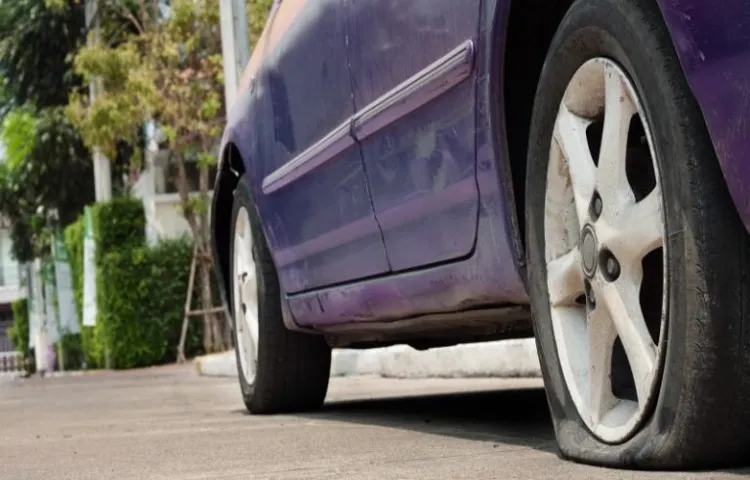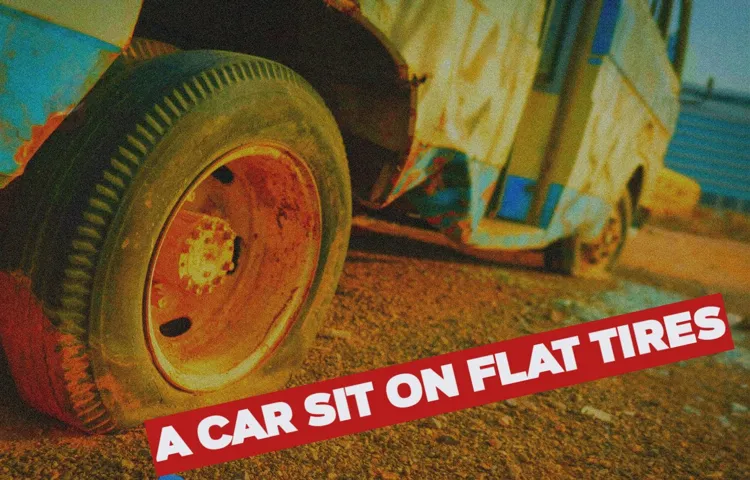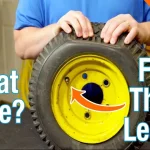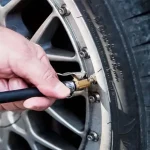Have you ever found yourself putting off fixing a flat tire, wondering how long it can sit? Maybe you don’t have time to go to the mechanic right away, or perhaps you’re not sure if it’s safe to drive on a flat tire. Whatever the reason, it’s important to know that a flat tire should not be left sitting for too long. While the exact amount of time can vary depending on a few factors, leaving a flat tire out of commission for too long can cause serious damage and even put your safety at risk.
In this blog post, we’ll explore just how long a flat tire can sit and what can happen if you leave it untouched for too long. So buckle up and let’s dive in!
Table of Contents
Factors That Affect the Service Life of a Flat Tire
If you’re wondering how long can a flat tire sit without any damage, it really depends on several factors. The first one is the type of tire. If you have a high-quality tire with a strong sidewall, it can withstand the weight of the car for a longer period of time.
On the other hand, if you have a low-quality tire, it will deteriorate faster. The second factor is the load on the tire. The more weight placed on the tire, the faster it will deflate and possibly even cause structural damage.
The third factor is the temperature. Hot temperatures can cause the rubber to break down and make it more susceptible to punctures. So if you live in a warmer climate, a flat tire can deteriorate even faster than in a cooler one.
Other factors to consider include the age of the tire and the type of surface it is sitting on. So if you have a flat tire, it’s best to have it repaired or replaced as soon as possible to prevent any further damage and ensure your safety on the road.
Temperature
Temperature Flat tires can be caused by many factors, and one of the most important ones to consider is temperature. Extreme heat or cold can have a significant impact on the service life of a tire. In hot weather, the air inside the tire expands, which can cause it to burst if the pressure is too high.
On the other hand, in cold weather, the rubber on the tire can become more brittle and prone to cracking, which can also shorten the life of the tire. Additionally, temperature fluctuations can cause the tire to lose pressure more quickly, which can result in a flat tire. To help prolong the life of your tires, it’s essential to monitor air pressure and make sure your tires are correctly inflated for the current temperature conditions.
It’s also crucial to store your tires in a dry, cool place when they are not in use to prevent any unnecessary weather-related damage.

Air Pressure
Air pressure is a critical factor in determining the service life of a flat tire. There are various reasons why a tire may go flat, but an inadequate amount of air pressure is the most common culprit. The recommended pressure for your tires can be found in your car’s manual or on the side of the tire.
Factors such as temperature changes and altitude can also affect tire pressure, and it is essential to regularly check and adjust the pressure accordingly. Overinflated tires can lead to a bumpy ride and even cause tire damage, while underinflated tires can result in poor fuel economy and increase the risk of blowouts. Therefore, ensuring that your tires are at the correct air pressure can not only extend their life but also ensure your safety on the road.
Remember, your tires are the only contact point between your car and the road, so it’s essential to check them regularly.
Condition of the Tire
As a car owner, it’s essential to maintain a healthy set of tires to ensure your safety on the road. However, several factors can affect the service life of a flat tire, influencing its condition and longevity. Mainly, the tire’s age, road conditions, weather, and the driver’s behavior are significant determinants.
Over time, the rubber compound of the tire becomes less flexible, leading to cracking, which weakens its structure. Additionally, prolonged exposure to heat and sunlight accelerates this process, reducing its lifespan. Similarly, rough and uneven roads cause the tire to wear out faster, while wet and snowy conditions reduce its grip, leading to skids and accidents.
Finally, the way you drive, including your speed, braking, acceleration, and turning, impacts the tire’s condition. Abrupt braking and sharp turns put undue pressure on the tire, leading to wear and tear. Therefore, it’s essential to frequently inspect your tires’ condition and replace any worn-out ones to guarantee your safety on the road.
Consequences of Driving on a Flat Tire
Wondering how long can a flat tire sit without causing damage? The truth is, driving on a flat tire is never a good idea, as it can lead to severe consequences such as tire blowouts, bent rims, and even accidents. Not only that, but it can also lead to costly repairs and replacements. The longer a flat tire sits without being replaced or repaired, the more it becomes prone to damage from exposure to the elements, such as weather conditions, debris, and even rodents.
So, if you find yourself with a flat tire, it’s best to address the issue promptly and avoid driving on it. This will not only prevent further damage but also ensure your safety on the road. In any case, if you’re unsure about how long your flat tire can sit before needing a replacement, it’s always best to consult with a professional mechanic for guidance.
Damage to the Wheel
Driving on a flat tire can lead to severe damage to the wheel. When you continue driving with a flat tire, it puts excessive pressure on the wheel, and the weight of the car rests on the sidewalls of the tire. As a result, the tire walls start to break down, and if you do not address the situation immediately, it can lead to the complete destruction of the tire.
It is essential to understand that a flat tire does not have any cushioning effect and will expose the wheel to all the bumps and shocks on the road. The continuous friction generated can cause heat buildup, which can further damage the wheel. Moreover, driving on a flat tire can result in bent rims, which can impact the vehicle’s handling and performance.
The best course of action is to pull over as soon as you notice a flat tire and have it repaired or replaced by a professional mechanic to avoid the consequences of driving on a flat tire.
Tire Sidewall Failure
Driving on a flat tire can have disastrous consequences, especially if it leads to a tire sidewall failure. When a tire loses air, it puts undue strain on the sidewall, which can cause it to weaken and eventually give out. This, in turn, can cause the tire to blow out, leaving you stranded on the road or worse, causing an accident.
It’s vital to monitor your tires regularly and fix any punctures or leaks promptly. If you do find yourself driving on a flat tire, slow down, and avoid hard turns or sudden braking, as this will only exacerbate the strain on the sidewall. In the end, it’s better to be cautious and pull over to the side of the road to change the flat tire than risk a tire blowout.
Remember, the cost of a new tire is trivial compared to the potential costs of an accident. So, stay safe, and take proper care of your tires!
Difficulty Controlling the Vehicle
Driving on a flat tire can be dangerous, and one of the main consequences is difficulty in controlling the vehicle. As soon as you realize you have a flat tire, it’s important to pull over safely and assess the situation. If you continue to drive on a flat, you’ll feel the handling of the vehicle become sluggish, and it will be harder to steer and brake.
This can lead to accidents and collisions, putting you and others in harm’s way. In addition, driving on a flat tire for too long can cause damage to other parts of your car, such as the rims and suspension, leading to costly repairs. It’s crucial to replace the tire or have it repaired as soon as possible to avoid any further damage and ensure your safety on the road.
So, if you find yourself driving on a flat tire, don’t take any chances and pull over promptly to avoid risking your life and the lives of others.
Actions to Take When You Have a Flat Tire
If you find yourself with a flat tire, it’s important to take action as soon as possible. Leaving a flat tire for too long can cause damage to the rim and potentially leave you stranded on the side of the road. But how long can a flat tire sit before causing significant damage? The answer can vary depending on the tire and the conditions it’s exposed to.
In general, it’s best to have a flat tire repaired or replaced within 24-48 hours. If the tire shows signs of significant damage or has been driven on for a longer period, it’s best to replace it entirely. Regularly inspecting your tires for signs of wear and tear can help prevent unexpected flats and potential damage.
And if you do find yourself with a flat, be sure to pull over to a safe location, use hazard lights, and call for roadside assistance or change the tire yourself if you feel comfortable doing so.
Replace the Tire Immediately
When you experience a flat tire, it’s essential to act promptly to ensure your vehicle’s safety and prevent further damage. The first and most crucial action to take is to pull over to a safe location away from oncoming traffic. Once you’re safely off the road, you can examine the tire to check for any visible damage or punctures that may have caused the flat.
If you can safely change the tire yourself, use your vehicle’s manual to locate the spare tire, jack, and lug wrench. If you don’t feel confident changing the tire yourself, call a roadside assistance service for help. Remember, driving on a flat tire can cause additional damage to your vehicle’s rim, suspension, and alignment, so it’s vital to replace the tire immediately.
If you’re unsure about the condition of your tire or need help finding a replacement, seek the advice of a professional mechanic or tire specialist. Don’t risk causing further damage to your vehicle or endangering your safety on the road. Act quickly and replace your flat tire as soon as possible to keep your vehicle running smoothly and safely.
Inflate the Tire and Test for Leaks
Inflating the tire and testing for leaks is a critical step to take when you have a flat tire. First, locate your spare tire and necessary tools like the tire jack and lug wrench. Once you have the necessary items, loosen the lug nuts of the flat tire, making sure not to remove them fully.
Then, place the jack under the vehicle and raise it until the flat tire is off the ground. Remove the lug nuts and take off the flat tire. Before mounting the spare tire, inspect it for any damage or punctures.
Once you have verified that the spare tire is in good condition, mount it onto the wheel and tighten the lug nuts. Then lower the vehicle to the ground and tighten the lug nuts further using your lug wrench. Finally, inflate the tire to the manufacturer’s recommended PSI and check for any air leaks by spraying soapy water around the valve stem and tire bead.
If bubbles appear, there may be a leak, and it will require a repair. It’s also essential to monitor the spare tire’s air pressure often and repair any punctures promptly. Remember, driving with underinflated tires can reduce your vehicle’s fuel efficiency and cause excessive tire wear, which can be dangerous on the road.
Inspect the Tire and Wheel for Damage
When faced with a flat tire, the first thing you should do is inspect both the tire and wheel for damage. This will help you determine whether the tire can be repaired or needs to be replaced entirely. Start by examining the tire itself for any punctures or cuts.
If you see any, it’s likely that the tire cannot be fixed and will need to be replaced. Be sure to also check the sidewalls, as any bulges or bubbles can indicate a weakened structure and necessitate a replacement. Next, turn your attention to the wheel.
Look for any dents, bends, or cracks that could’ve caused the flat tire. In particular, make sure to check the rim where it meets with the tire, as this is a common area for damage to occur. By taking the time to carefully inspect both the tire and wheel, you’ll be able to make an informed decision on the best course of action.
Remember, safety always comes first, and replacing a damaged tire is essential for both your well-being and that of your passengers.
Conclusion
In conclusion, a flat tire can sit for as long as you want it to, but it won’t fix itself. While it may seem tempting to put off dealing with a flat tire, it’s important to address the issue sooner rather than later. After all, leaving a flat tire sitting for too long is like leaving a bad hair day without a hat – it’s not going to fix itself and it’s not going to go away on its own.
So, if you want to avoid a messy blowout or being stranded on the side of the road, take care of your flat tire as soon as possible. Trust us, your car (and your head) will thank you.”
FAQs
What is the maximum time a flat tire can be left unused?
It’s not recommended to leave a flat tire unused for more than six months as it can cause damage to the tire’s rubber compounds.
Can a damaged tire be repaired if it has been flat for a long time?
It depends on the extent of the damage the tire has suffered. If it’s been flat for too long, it may have caused irreversible damage, such as sidewall cracks. In such cases, it’s better to replace the tire instead of repairing it.
What is the ideal way to store a flat tire for an extended time?
The best way to store a flat tire for a long time is by keeping it in a cool, dry, and dark place away from direct sunlight. Also, make sure to keep the tire off the ground and stacked on a vertical position.
Can a permanently flat tire be reused?
A tire that has been permanently flat, that is, it’s lost its ability to hold air, is no longer useful and cannot be reused.
How often should I check the flat tire’s pressure if it’s not in use?
It’s recommended to check the flat tire’s pressure at least once a month, even if it’s not in use. This will help ensure that the tire’s rubber compounds stay in good condition.
Will a flat tire cause any damage to my vehicle?
Yes, driving on a flat tire or with significantly low tire pressure can cause damage to your vehicle’s rim and suspension system.
Can a flat tire be inflated and used again after a long time?
It’s not safe to inflate and use a tire that has been flat for a long time as it can cause visible bumps, bubbles, and sidewall damage. Such a tire can blow out unexpectedly, endangering the driver and passengers.



